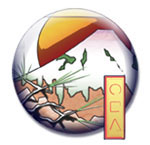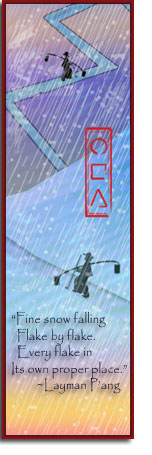On The Way: The Daily Zen Journal
The Formless Precepts
Hui-neng (638-713)
The Four Boundless Vows
Good friends, while I confer on you the Formless Precepts, you must all experience this for yourselves. Recite this together with me, and it will enable you to see the three-bodied buddha within you:
“I take refuge in the pure dharma-body buddha in my own material body.
I take refuge in the myriad-fold transformation-body buddha in my own material body.
I take refuge in the future and perfect realization-body buddha in my own material body.”
This material body is an inn and not a fit refuge. But the three bodies I just mentioned are your ever-present dharma nature. Everyone has them. But because people are deluded, they don’t see them. They look for the three-bodied tathagata outside themselves and don’t see the three-bodied buddha in their own material body.
Good friends, listen to this good friend of yours, and I will tell you how to see within your material body the three-bodied buddha that arises from this nature of yours.
What do we mean by the pure dharma-body buddha? Good friends, everyone’s nature is fundamentally pure. The ten thousand dharmas are present in this nature. If we think about doing something bad, we commit bad deeds. And if we think about doing something good, we perform good deeds. Thus, we know all dharmas are present in our nature.
But our nature itself remains pure. The sun and moon are always shining. It is only due to cloud cover that there is light above but darkness below, and we can’t see the sun or moon or stars. Then suddenly the wind of wisdom comes along and blows the clouds and drives the fog away, and a panorama of ten thousand images appears all at once.
Our nature is pure like the clear sky above, and our wisdom is like the sun and moon. Our wisdom is always shining, but if externally we become attached to objects, the clouds of delusion cover up our nature, and we can’t see it. Then, because we meet a good friend who explains the true teaching, our delusions are blown away, and everything inside and outside becomes perfectly clear, and the ten thousand dharmas in this nature of ours all appear.
This nature of ours in which the ten thousand dharmas are present, is what we mean by the pure dharma body. Those of you who take refuge in yourselves, if you get rid of bad thoughts and bad practices, this is called taking refuge. 
What do we mean by the myriadfold transformation-body? If we didn’t think, our nature would be utterly empty. When we think, we transform ourselves. If we think evil thoughts, we turn into the denizens of hell. If we think good thoughts, we turn into the deities of heaven. Malice turns us into beasts. Compassion turns us into bodhisattvas. Wisdom transports us to the higher realms, and ignorance sends us into the lower depths. Our nature is constantly transforming itself. But deluded people are unaware of this.
Once we think of goodness, wisdom arises. One lamp can dispel a thousand years of darkness, and one thought of wisdom can end ten thousand years of ignorance. Don’t think about what’s past. Keep thinking about what’s next. When your next thought is always good, this is what we call the realization body. One bad thought results in the destruction of a thousand good ones. But one good thought results in the annihilation of a thousand years of bad ones. In the face of impermanence, if your next thought is good, this is what we call the realization body.
The thoughts that come from the dharma body are your transformation body. And when every thought is good, this is your realization body. When you yourself become aware of this, and when you yourself cultivate this, this is called taking refuge. Your material body is made of flesh and bones. Your material body is but an inn and not a fit place for refuge. Just become aware of your three bodies, and you will understand what is truly important.
Good friends, having taken refuge in the three-bodied buddha, let us now make Four Boundless Vows. Good friends, recite after me:
“I vow to save all beings, no matter how numberless.
I vow to end all afflictions, no matter how countless.
I vow to master all teachings, no matter how limitless.
I vow to attain buddhahood, no matter how transcendent.”
Good friends, as for “I vow to save all sentient beings, no matter how numberless,” it isn’t Hui-neng who does the saving. Good friends, every being you can think of saves themselves with their own nature in their own bodies.
What does it mean “they save themselves with their own nature?” The wrong views and afflictions, the ignorance and delusions of their own material bodies already possess the nature of original enlightenment. It is just this nature of original enlightenment that saves them with right views.
Once they realize the prajna wisdom of right views, they dispel their ignorance and delusion, and each being saves themselves. The false are saved with truth. The deluded are saved with awareness. The ignorant are saved with wisdom. The bad are saved with goodness. And the afflicted are saved with enlightenment. Those who are saved like this are truly saved.
As for “I vow to end all afflictions, no matter how countless,” this means to get rid of the delusions of your own mind. And “I vow to master all teachings, no matter how limitless” means to study the true, unexcelled Dharma. And “I vow to attain buddhahood, no matter how transcendent,” means always to practice with humility, to respect all beings, to avoid attachments, to give rise to prajna from your own awareness, and to put an end to delusions. This is the power of making vows.
Hui-neng (638-713)
Excerpted from The Platform Sutra – The Zen Teachingn of Hui-neng translated by Red Pine 2006





Taking refuge and making vows are not subjects we speak about in casual conversation, even with ourselves! Traditionally, we think of a formal ceremony where a teacher is initiating a group of students into the commitment of embracing Buddhism as their path. Before taking that step, there is the process of looking closely at what you’re committing to, and that involves examination as to why you think you’re here to begin with and what is worth committing your time to.
Rather than just inheriting a family’s belief system, or the culture’s dominant religious system, there is this time and space in one’s life of awakening to questioning. In Buddhism, we are encouraged to look for ourselves, not merely to accept a belief or practice without examination first. Even in Buddha’s last moments on earth, he reminded his followers to be a lamp unto themselves. So, before taking refuge and vows, there could be years of questioning reflected in that moment.
This section of the Platform Sutra is most powerful as Hui-neng explains the Formless Precepts in a most surprising way. He brings us back inside to realize where this buddha body exists here and now and how it functions. Taking refuge is not just a passive acceptance of a belief system, but rather a very active engagement each day in awareness and the actions based on that awareness. It is not something you go through and move from, mindlessly repeating formulaic vows. You are placed in the center, taking responsibility for the karma of each thought indulged in. While many thoughts may come and go, awareness can choose which to discard and what to act on.
Our nature is pure like the clear sky above, and our wisdom is like the sun and moon. Our wisdom is always shining, but if externally we become attached to objects, the clouds of delusion cover up our nature, and we can’t see it.
May we stay close to our intention,
Elana, Scribe for Daily Zen